JUNE KEY FIGURES
 |  | % change Mar qtr 06 to Jun qtr 06 | % change Jun qtr 05 to Jun qtr 06 |
|
| GDP (Chain volume measure) |  |  |
 | Trend | 0.5 | 2.3 |
 | Seasonally adjusted | 0.3 | 1.9 |
| Final consumption expenditure (Chain volume measure) |  |  |
 | Trend | 0.7 | 2.6 |
 | Seasonally adjusted | 0.7 | 2.6 |
| Gross fixed capital formation (Chain volume measure) |  |  |
 | Trend | 1.3 | 7.7 |
 | Seasonally adjusted | 2.7 | 7.2 |
| GDP chain price index |  |  |
 | Original | 1.4 | 4.6 |
| Terms of trade |  |  |
 | Seasonally adjusted | 1.9 | 6.7 |
| Real net national disposable income |  |  |
 | Trend | 1.1 | 4.1 |
 | Seasonally adjusted | 0.8 | 3.0 |
|
GDP growth rates, Chain volume measure, quarterly change
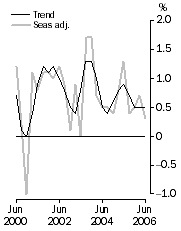
| Contributions to GDP growth, Expenditure - Seasonally adjusted
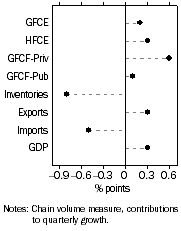
|
JUNE KEY POINTS
VOLUME GDP
- In trend terms, GDP increased by 0.5% in the June quarter. GDP per capita grew by 0.2%, Real net national disposable income grew by 1.1% and GDP per hour worked in the market sector increased 0.4%.
- In seasonally adjusted terms, GDP increased by 0.3% in the June quarter. Gross fixed capital formation increased by 2.7%.
EXPENDITURE ON GDP
- In seasonally adjusted terms, the increase in expenditure on GDP was a result of positive contributions from Final consumption expenditure (+0.5 percentage points), Private business investment (+0.3 percentage points) and Dwellings (+0.2 percentage points). This growth was offset by negative contributions from Changes in inventories (-0.8 percentage points) and Net exports (-0.2 percentage points).
INDUSTRY GROSS VALUE ADDED
- In seasonally adjusted terms, the strongest contributions to growth were from Construction, up 0.3 percentage points, and a range of other industries up 0.1 percentage points. This growth was offset by negative contributions from Agriculture, forestry and fishing, Wholesale and Communications (each -0.1 percentage points).
NOTES
FORTHCOMING ISSUES
| ISSUE (QUARTER) | Release Date |
| September 2006 | 6 December 2006 |
| December 2006 | 7 March 2007 |
FEATURE ARTICLE
An article, 'Measuring changes in labour costs' is being released with this publication and is available on this site.
REVISIONS IN THIS ISSUE
Revisions have been made to a number of aggregates due to the incorporation of updated source data. Of note are downward revisions to Private gross fixed capital formation - Machinery and equipment - in December quarter 2005 and March quarter 2006. This is the result of identification of some misreporting of expenditure by asset type.
Seasonal reanalysis is also the source of some revisions. In particular, a number of Private gross fixed capital formation series have been reanalysed and seasonally adjusted series for hours worked have been updated.
In addition to these normal quarterly revisions there are a number of other factors influencing the estimates that have led to revisions to both the level and the movement of GDP and its components. First, a new base year, 2004-05, has been introduced into the volume estimates which has resulted in revisions to growth rates in subsequent periods. Second, the volume estimates have been re-referenced to 2004-05 thus preserving additivity in the quarters after the reference year. Re-referencing affects the levels of, but not the movements in, volume estimates.
In aggregate, these various sources of revision have reduced growth in the volume measure of GDP in March quarter 2006 by 0.2 percentage points.
CHANGES IN THIS ISSUE
With the release of this publication, the Lotus 1-2-3 .wks spreadsheets have been discontinued and replaced with Excel .xls spreadsheets. For more information, see the Recent Releases section, on page 14.
CHANGES IN THE NEXT ISSUE
The September quarter 2006 release of this publication will contain revisions to many series as a result of benchmarking quarterly series to updated annual benchmarks from the annual supply and use tables. These annual benchmarks will be released in Australian System of National Accounts, 2005-06 (cat. no. 5204.0) on 1 November 2006. Quarterly revisions will also result from the annual seasonal reanalysis that is undertaken on all series.
FORTHCOMING NATIONAL ACCOUNTS RELEASES
In addition to the release of 5204.0 (see above), other related national accounts to be released in the next 3 months include Australian National Accounts: Financial Accounts (cat. no. 5232.0), for June quarter 2006, on 29 September 2006 and Australian National Accounts: State Accounts, 2005-06 (cat. no. 5220.0), on 8 November 2006.
INQUIRIES
For further information about these and related statistics, contact the National Information and Referral Service on 1300 135 070 or Terry Rawnsley on Canberra (02) 6252 6711.
MAIN FEATURES EXPENDITURE CHAIN VOLUME MEASURES
 |  |  | Trend | Seasonally adjusted |  |
 |  |  | Quarterly % change Mar 06 to Jun 06 | Annual % change Jun 05 to Jun 06 | % points contribution to growth in GDP Mar 06 to Jun 06 | Quarterly % change Mar 06 to Jun 06 | Annual % change Jun 05 to Jun 06 | % points contribution to growth in GDP Mar 06 to Jun 06 |  |
|  |
| Final consumption expenditure |  |  |  |  |  |  |  |
 | General government | 0.5 | 2.5 | 0.1 | 1.1 | 2.7 | 0.2 |  |
 | Households | 0.7 | 2.6 | 0.4 | 0.6 | 2.6 | 0.3 |  |
| Gross fixed capital formation |  |  |  |  |  |  |  |
 | Private |  |  |  |  |  |  |  |
 |  | Dwellings | -0.5 | -4.6 | - | 3.7 | -4.0 | 0.2 |  |
 |  | Business investment | 1.3 | 12.4 | 0.2 | 2.0 | 11.5 | 0.3 |  |
 |  | Ownership transfer costs | 5.1 | 9.4 | 0.1 | 4.5 | 4.9 | 0.1 |  |
 | Public | 1.5 | 10.1 | 0.1 | 3.4 | 12.3 | 0.1 |  |
| Changes in inventories |  |  |  |  |  |  |  |
 | Private non-farm | . . | . . | -0.2 | . . | . . | -0.7 |  |
 | Farm and public authority | . . | . . | - | . . | . . | -0.1 |  |
| Gross national expenditure | 0.6 | 3.3 | 0.6 | 0.5 | 3.0 | 0.5 |  |
| Exports of goods and services | 0.9 | 2.2 | 0.2 | 1.4 | 1.6 | 0.3 |  |
| Imports of goods and services | 1.8 | 7.2 | -0.4 | 2.2 | 7.0 | -0.5 |  |
| Statistical discrepancy (E) | . . | . . | 0.1 | . . | . . | 0.1 |  |
| Gross domestic product | 0.5 | 2.3 | 0.5 | 0.3 | 1.9 | 0.3 |  |
|  |
| . . not applicable |
| - nil or rounded to zero (including null cells) |
JUNE QUARTER
Summary Comments
Final Consumption Expenditure
- Household final consumption expenditure grew by 0.7% in trend terms (0.6% seasonally adjusted), with the main contributors to growth being Rent and other dwelling services and Furnishings and household equipment, offset by a fall in Operation of vehicles.
Gross fixed capital formation (GFCF)
- Private business investment increased by 1.3% in trend terms (2.0% seasonally adjusted). The seasonally adjusted growth was largely due to Non-dwelling construction (up 3.9%).
- In seasonally adjusted terms, Dwellings increased by 3.7%, the first increase since June quarter 2005. Both New dwellings (up 4.5%) and Alterations and additions (up 2.7%) increased during the quarter.
- Public GFCF continued its recent strong growth, increasing 3.4% (seasonally adjusted). It has grown 10.1% in trend terms since June quarter 2005.
Changes in inventories
- Total inventories decreased by $264 million in trend terms, following a rise of $383 million in the March quarter. In seasonally adjusted terms, total inventories fell $882 million compared to a $922 million increase in March. As a result, changes in inventories detracted 0.8 percentage points from seasonally adjusted GDP growth during the June quarter.
Exports and imports of goods and services
- In trend terms, Exports of goods and services increased 0.9% (1.4% seasonally adjusted) in the June quarter.
- Imports of goods and services increased by 1.8% in trend terms (2.2% seasonally adjusted) in the June quarter.
MAIN FEATURES PRODUCTION CHAIN VOLUME MEASURES
 | Trend | Seasonally adjusted |  |
 | Quarterly % change Mar 06 to Jun 06 | Annual % change Jun 05 to Jun 06 | % points contribution to growth in GDP Mar 06 to Jun 06 | Quarterly % change Mar 06 to Jun 06 | Annual % change Jun 05 to Jun 06 | % points contribution to growth in GDP Mar 06 to Jun 06 |  |
|  |
| Agriculture, forestry and fishing | -0.8 | -0.4 | - | -4.9 | -1.4 | -0.1 |  |
| Mining | -1.3 | -6.7 | -0.1 | 1.3 | -8.3 | 0.1 |  |
| Manufacturing | -1.0 | -2.9 | -0.1 | -0.1 | -2.4 | - |  |
| Electricity, gas and water supply | 2.7 | 6.5 | 0.1 | 3.5 | 6.4 | 0.1 |  |
| Construction | 1.5 | 6.9 | 0.1 | 4.1 | 7.2 | 0.3 |  |
| Wholesale trade | 0.3 | 2.4 | - | -1.1 | 0.9 | -0.1 |  |
| Retail trade | 0.8 | 2.1 | - | 0.2 | 2.1 | - |  |
| Accommodation, cafes and restaurants | 0.3 | 3.2 | - | -0.3 | 2.8 | - |  |
| Transport and storage | 1.4 | 3.9 | 0.1 | 1.0 | 4.1 | - |  |
| Communication services | 0.9 | 7.4 | - | -1.8 | 5.7 | -0.1 |  |
| Finance and insurance | 1.9 | 6.9 | 0.1 | 1.6 | 6.7 | 0.1 |  |
| Property and business services | 0.9 | 4.7 | 0.1 | 1.0 | 4.1 | 0.1 |  |
| Government administration and defence | 0.3 | 1.9 | - | 0.2 | 2.0 | - |  |
| Education | 0.4 | 1.7 | - | 0.4 | 1.7 | - |  |
| Health and community services | 0.3 | 3.7 | - | 0.5 | 3.5 | - |  |
| Cultural and recreational services | -1.1 | -1.4 | - | 1.3 | - | - |  |
| Personal and other services | 0.7 | 0.8 | - | 3.6 | 2.8 | 0.1 |  |
| Ownership of dwellings | 0.9 | 3.9 | 0.1 | 1.0 | 3.9 | 0.1 |  |
| Taxes less subsidies on products | 0.2 | 1.2 | - | -0.1 | 1.1 | - |  |
| Statistical discrepancy (P) | . . | . . | - | . . | . . | -0.3 |  |
| Gross domestic product | 0.5 | 2.3 | 0.5 | 0.3 | 1.9 | 0.3 |  |
|  |
| . . not applicable |
| - nil or rounded to zero (including null cells) |
JUNE QUARTER
Summary Comments
Agriculture, Forestry and Fishing
- The trend estimate decreased by 0.8%. The seasonally adjusted estimate fell 4.9%, driven by falls in wool production (down 14.6%), non-cereal crop production (down 7.2%) and livestock slaughterings (down 2.8%).
Mining
- The trend estimate fell by 1.3% but the seasonally adjusted estimate was up 1.3%. There was a 2.4% fall in 2005-06 compared with 2004-05, with oil and gas production down 6.0% and gold production down 4.5%.
Manufacturing
- The trend estimate fell by 1.0% (0.1% seasonally adjusted). The main industries to decrease were food, beverages and tobacco (-2.1%) and machinery and equipment (-2.1%), however these were almost offset by increased growth in textiles, clothing and footwear (9.2%) and chemical, petroleum and coal products (3.9%).
Construction
- The trend estimate increased by 1.5% and the seasonally adjusted estimate by 4.1%.
Transport and storage
- Increased 1.4% in trend terms (1.0% seasonally adjusted). Seasonally adjusted, road (1.8%), rail (1.2%) and air transport (3.6%) grew but services to transport and storage fell by 1.1%.
Wholesale and Retail Trade
- In trend terms these industries increased by 0.3% and 0.8% respectively. In seasonally adjusted terms the wholesale industry declined by 1.1% while the retail industry increased by 0.2%. For the wholesale industry the basic materials sector showed weaker growth than usual.
MAIN FEATURES INCOME AT CURRENT PRICES
 |  | Trend | Seasonally adjusted |  |
 |  | Quarterly % change Mar 06 to Jun 06 | Annual % change Jun 05 to Jun 06 | % points contribution to growth in GDP Mar 06 to Jun 06 | Quarterly % change Mar 06 to Jun 06 | Annual % change Jun 05 to Jun 06 | % points contribution to growth in GDP Mar 06 to Jun 06 |  |
|  |
| Compensation of employees | 1.6 | 6.8 | 0.7 | 2.0 | 7.0 | 0.9 |  |
| Gross operating surplus |  |  |  |  |  |  |  |
 | Private | 1.4 | 9.0 | 0.3 | 2.2 | 7.8 | 0.4 |  |
 | Other | 1.5 | 6.0 | 0.2 | 0.8 | 5.4 | 0.1 |  |
| Gross mixed income | 1.0 | 4.2 | 0.1 | 0.7 | 4.0 | 0.1 |  |
| Taxes less subsidies on production and imports | 1.4 | 4.7 | 0.2 | 0.5 | 4.7 | 0.1 |  |
| Statistical discrepancy (I) | . . | . . | -0.1 | . . | . . | 0.2 |  |
| Gross domestic product | 1.4 | 6.6 | 1.4 | 1.8 | 6.3 | 1.8 |  |
|  |
| . . not applicable |
JUNE QUARTER
Summary Comments
Compensation of employees(COE)
- Compensation of employees represented 53.5% of total factor income in the June quarter. The trend increase of 1.6% in the June quarter reflected a rise of 0.9% in average earnings and a 0.6% rise in the number of wage and salary earners. Seasonally adjusted, compensation of employees grew by 2.0%. Average earnings and the number of wage and salary earners both increased by 1.0%.
Wages(a) share of total factor income: Trend
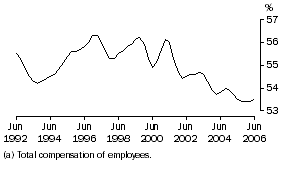
Gross operating surplus (GOS)
- Gross operating surplus of corporations remained at historically high levels, representing 27.2% of total factor income in the June quarter. The June quarter saw a 1.3% increase in trend GOS and 1.5% seasonally adjusted, with GOS of private non-financial corporations up 2.2% seasonally adjusted.
Profit(a) share of total factor income: Trend
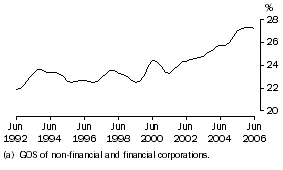
MAIN FEATURES STATE FINAL DEMAND CHAIN VOLUME MEASURES
 | Trend | Seasonally adjusted |  |
 | Quarterly % change Mar 06 to Jun 06 | Annual % change Jun 05 to Jun 06 | % points contribution to growth in DFD Mar 06 to Jun 06 | Quarterly % change Mar 06 to Jun 06 | Annual % change Jun 05 to Jun 06 | % points contribution to growth in DFD Mar 06 to Jun 06 |  |
|  |
| New South Wales | 0.2 | 1.5 | 0.1 | 0.2 | 1.1 | 0.1 |  |
| Victoria | 0.1 | 1.4 | - | 0.6 | 1.1 | 0.1 |  |
| Queensland | 1.6 | 7.7 | 0.3 | 0.7 | 7.3 | 0.1 |  |
| South Australia | 0.1 | 1.4 | - | -0.6 | 0.5 | - |  |
| Western Australia | 2.9 | 11.7 | 0.3 | 5.6 | 14.0 | 0.6 |  |
| Tasmania | -0.1 | 3.2 | - | 0.1 | 3.5 | - |  |
| Northern Territory | 0.9 | 3.5 | - | -1.4 | - | - |  |
| Australian Capital Territory | 0.7 | 4.1 | - | 2.6 | 5.2 | 0.1 |  |
| Australia (DFD)(a) | 0.8 | 3.9 | 0.8 | 1.2 | 3.8 | 1.2 |  |
|  |
| - nil or rounded to zero (including null cells) |
| (a) Domestic final demand. |
JUNE QUARTER
Summary Comments
State Final Demand
- In trend terms, growth in the June quarter was strongest in Western Australia (up 2.9%). In seasonally adjusted terms, Western Australia (up 5.6%) showed the strongest growth with the major contributor being private gross fixed capital formation. The Northern Territory and South Australia recorded falls in seasonally adjusted terms (down 1.4% and 0.6% respectively), due predominantly to falls in private gross fixed capital formation.
Household final consumption expenditure
- In trend terms, all states experienced growth, ranging from 1.2% in the Northern Territory to a low of 0.5% in Tasmania. Seasonally adjusted growth was recorded in all states, with Western Australia the strongest (up 1.2%).
Government final consumption expenditure
- Trend growth in the June quarter was strongest in Queensland and Tasmania (each up 1.5%), while the lowest was in South Australia (down 0.9%). Seasonally adjusted growth fell in South Australia (down 2.1%), while all other states recorded growth with the strongest in Western Australia (up 5.7%).
Private gross fixed capital formation
- In trend terms, the strongest growth was recorded in the Australian Capital Territory (up 5.7%). Trend growth was weakest in Tasmania (down 3.1%).
- In seasonally adjusted terms, machinery and equipment was mixed, with the Australian Capital Territory recording the strongest growth (up 23.1%), while the Northern Territory recorded the largest fall (down 11.2%). The strongest growth in Non-dwelling construction occurred in the Australian Capital Territory (up 60.4%), with the weakest growth in Tasmania (down 24.8%). Dwelling investment growth was up in the Northern Territory (up 7.8%), while Tasmania had the largest fall (down 7.7%).
Public gross fixed capital formation
- Trend growth was strongest in Western Australia (up 7.3%), while the largest fall was recorded in the Australian Capital Territory (down 6.3%). In seasonally adjusted terms, strong growth was recorded in Western Australia (up 24.2%), while a large fall occurred in the Northern Territory (down 14.3%).
ANALYSIS AND COMMENTS
GROWTH RATES IN GDP
Following the fall in GDP (in seasonally adjusted volume terms) in December quarter 2000, there have been 22 consecutive quarters of growth, averaging around 0.8% per quarter.
Percentage changes, Chain volume measures

The growth (in trend volume terms) over the past four quarters was driven by Household final consumption expenditure (up 2.6%), Private investment in machinery and equipment (up 13.6%) and New engineering construction (up 16.1%). The 2.6% growth in Household final consumption expenditure has been weaker than the growth experienced during 2003 and 2004.
Offsetting the growth during the past four quarters was a strong rise in Imports of goods and services (up 7.2%) and a fall in Dwelling investment (down 4.6%).
On the production side, the strongest industries (in trend volume terms) over the past four quarters have been Finance and insurance, Property and business services (both contributing 0.5 percentage points to GDP growth) and Construction (0.4 percentage points). Detracting from growth over the past four quarters were Mining (0.4 percentage points) and Manufacturing (0.3 percentage points).
Selected Industries Contribution to growth, June qtr 05 to June qtr 06 - Trend
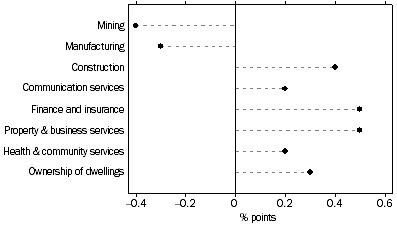
REAL GROSS DOMESTIC INCOME
The real purchasing power of income generated by domestic production can be affected by changes in import and export prices. Real gross domestic income adjusts the volume measure of GDP by the Terms of trade. The graph below provides a comparison of quarterly movements in trend GDP (volume measure) and Real gross domestic income. During the June quarter, trend Real gross domestic income increased by 0.7%, compared to the increase in the trend volume measure of GDP of 0.5%, reflecting a 1.8% improvement in the trend Terms of trade.
Percentage changes, Trend
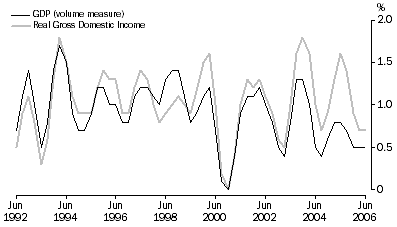
TERMS OF TRADE
The Terms of trade represent the relationship between the prices of exports and imports. An increase (decrease) in the Terms of trade reflects export prices increasing (decreasing) at a faster rate than import prices. The strong growth in the Terms of trade from June quarter 2003 (up 32.8%) reflected over 30% growth in export prices and relatively flat import prices over the period. The June quarter 2006 saw a 1.8% increase in trend terms to a record high since September quarter 1959 in the Terms of trade index.
Trend, (2004-05 = 100)

REAL NET NATIONAL DISPOSABLE INCOME
A broader measure of change in national economic well-being is Real net national disposable income. This measure adjusts the volume measure of GDP for the Terms of trade effect, Real net incomes from overseas and Consumption of fixed capital (see Glossary for definition). The graph below provides a comparison of quarterly movements in trend GDP (volume measure) and Real net national disposable income. During the June quarter, trend Real net national disposable income increased by 1.1%, with growth over the past 4 quarters at 4.1% compared to 2.3% for GDP.
Percentage changes, Trend
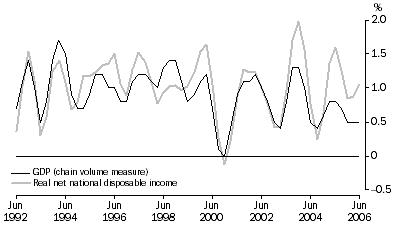
NET EXPORTS CONTRIBUTION TO GROWTH
Net exports represent the difference between exports and imports of goods and services. Net exports detract from GDP growth when the change in the volume of imports is greater than the change in the volume of exports. Since the September quarter 2003, when the contribution of Net exports to GDP growth was -0.6 percentage points in trend terms, the contribution of Net exports has been slowly trending upwards reaching -0.3 percentage points in the June quarter 2006.
Net Exports Contribution to growth, Volume measures

HOUSEHOLD SAVING RATIO
In both trend (-3.2%) and seasonally adjusted (-3.3%) terms the Household saving ratio was negative in June quarter 2006, implying that household consumption was greater than household disposable income.
Household savings cannot be directly measured by the National Accounts. Rather it is calculated as a residual item by deducting Household final consumption expenditure from Household gross disposable income. As the difference between the two aggregates is relatively small, caution should be exercised in interpreting the Household saving ratio in recent years, because major components of household income and expenditure may be subject to significant revisions. The impact of these revisions on the saving ratio can cause changes in the direction of the trend.
Household saving ratio, Current prices
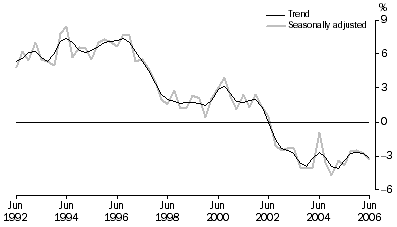
COMPENSATION OF EMPLOYEES
In June quarter 2006, seasonally adjusted Compensation of employees grew by 2.0%, while the seasonally adjusted number of employees recorded in the Labour Force survey grew by 1.0%. Thus, Average compensation per employee increased by 1.0%. Growth for the year in average compensation per employee was 4.4% compared to 4.1% growth over the same period in the total hourly rates of pay, excluding bonuses as published in Labour Price Index, Australia (cat. no. 6345.0). It should be noted that the conceptual bases for the two wage measures are different. More information on measuring labour costs is presented in a feature article linked to this issue. See abstract on page 15 for details.
PRIVATE NON-FARM INVENTORIES TO TOTAL SALES RATIO
In trend current price terms, the book value of Private non-farm inventories increased by $1,707 million (1.5%) in June quarter 2006, while total sales rose by $3,724 million (2.4%). Consequently, as sales have risen at a faster rate than inventories, the ratio decreased from 0.733 in the March quarter to 0.726 in the June quarter.
Trend, Current prices

IMPORTS TO DOMESTIC SALES
The Imports to domestic sales ratio, trended and at current prices, increased from 0.360 in the March quarter to 0.364 in the June quarter. This reflected a rise of 2.9% in Imports of goods accompanied by a 1.7% rise in Domestic sales.
Trend, Current prices

TREATMENT OF BANANAS IN THE NATIONAL ACCOUNTS
The large drop in sales of bananas in the June quarter 2006 caused by supply shortages as a result of the damage from Cyclone Larry (around 80% according to industry sources) are reflected in the June quarter 2006 volume measures.
The changes in the implicit price deflator (IPD) for household consumption of food do not align with the changes in the food group in the consumer price index (CPI). This is because the IPD reflects current period weights and so has a lower weight applied to bananas than is the case with the CPI.
RELIABILITY OF CONTEMPORARY TREND ESTIMATES
Trend estimates are used throughout this publication as an alternative approach to the analysis of movements in time series data. Further details regarding the procedures used to estimate the trend series are described in the Explanatory Notes (paragraphs 13 - 17) and in Information Paper: A Guide to Interpreting Time Series - Monitoring Trends (cat. no. 1349.0) released in August 2003.
Potential revisions to trend estimates can be indicated by showing the effects of particular changes in seasonally adjusted estimates that might occur in the next quarter. The table below shows the trend estimates for the last ten quarters and the values to which they would be revised if the given movements in seasonally adjusted GDP actually occurred in September quarter 2006. In the absence of any other revisions, Seasonally adjusted growth of 0.5% is required in September quarter 2006 to maintain, in September quarter 2006, the trend growth of 0.5% currently estimated for the June quarter 2006.
Percentage change in GDP Chain volume measure |
|  |
 |  |  |  | Trend estimate if seasonally adjusted GDP changes by the following amounts in September qtr 2006 |  |
 |  | Seasonally adjusted GDP as published in table 2 | Trend GDP as published in table 1 | Grows by 1.0% | No change | Falls by 1.0% |  |
|  |
| 2004 |  |  |  |  |  |  |
 | March | 0.7 | 1.0 | 1.0 | 1.0 | 1.0 |  |
 | June | 0.5 | 0.5 | 0.5 | 0.5 | 0.5 |  |
 | September | 0.5 | 0.4 | 0.3 | 0.3 | 0.3 |  |
 | December | 0.4 | 0.5 | 0.5 | 0.5 | 0.5 |  |
| 2005 |  |  |  |  |  |  |
 | March | 0.8 | 0.8 | 0.7 | 0.7 | 0.7 |  |
 | June | 1.3 | 0.9 | 0.8 | 0.8 | 0.8 |  |
 | September | 0.4 | 0.7 | 0.7 | 0.7 | 0.8 |  |
 | December | 0.5 | 0.6 | 0.7 | 0.6 | 0.5 |  |
| 2006 |  |  |  |  |  |  |
 | March | 0.7 | 0.5 | 0.8 | 0.5 | 0.3 |  |
 | June | 0.3 | 0.5 | 0.9 | 0.5 | 0.1 |  |
|  |
RECENT RELEASES
INPUT-OUTPUT TABLES, 2001-02 PRELIMINARY (CAT. NO. 5209.0.55.001)
Preliminary input-output tables for 2001-02 were released on Thursday 6 July. The tables presented are the core transaction tables of the input-output suite of tables compiled by ABS. The full set of tables will be released late in 2006. This is the first set of input-output tables that reflect the structure of the Australian economy following the changes to the indirect tax system, including the introduction of the goods and services tax (GST) on 1 July 2000. For more information refer to Australian National Accounts: Input-Output tables - Electronic Publication (cat. no. 5209.0.55.001).
CHANGES TO SPREADSHEETS FOR THE QUARTERLY AUSTRALIAN NATIONAL ACCOUNTS (CAT. NO. 5206.0.55.001)
On 9 June the ABS released an Information Paper on changes to the time series spreadsheets associated with the Australian National Accounts: National Income, Expenditure and Product (cat. no. 5206.0), resulting from the conversion of the current Lotus 1-2-3 .wks spreadsheets to Excel .xls format.
These changes come into effect with this issue of 5206.0 (June quarter 2006). From this issue, the current Lotus 1-2-3 .wks spreadsheets have been discontinued. For more information refer to Information Paper: Changes to Spreadsheets for the Quarterly Australian National Accounts (cat. no. 5206.0.55.001).
 Print Page
Print Page
 Print All
Print All